A Graph-Based Dynamic Modeling for Palm Oil Refining Process
Abstract
1. Introduction
2. Refining Process
3. Physical Refining
3.1. Degumming
3.2. Bleaching
3.3. Deodorization
- Free fatty acid (FFA)
- Free fatty acids (FFA) are formed when triglyceride, diglyceride, and monoglyceride are decomposed by chemical or enzymatic hydrolysis. Enzymes are used when there is a large amount of moisture in the palm oil [13]. Sometimes more than 2% FFA are produced. High FFA content must be avoided due to large refining losses and possible problems in the upcoming bleaching process [13].
- Moisture
- Palm oil consists of moisture. Under certain conditions, the triglyceride of palm oil is hydrolyzed into free fatty acids and glycerol [13]. However, the hydrolytic compound resultant from triglyceride molecules under 0.1% of moisture is negligible.C3H5(OOCR)3 + 3HOH → C3H5(OH) + 3HOOCRTherefore, in order to control the quantity of FFA, CPO must be stored with moisture content below 0.1% in order to eliminate further oxidation [9].
- Heavy (trace) metals
- Heavy metals or trace metals such as iron (Fe), copper (Cu), cadmium (Cd), lead (Pb), and manganese (Mn) are surrounded by phospholipids, proteins, lipids, and non-lipid compounds. The existence of trace metals due to corrosion reactions in the palm oil mill, storage and ship tanks, tankers, pipelines and refinery processes. Heavy metals are pro-oxidants that affect the quality of the palm oil. They act as catalyzers for hydro-peroxide decompositions. Iron (Fe) increases the rate of peroxide and copper (Cu) accelerates the decomposition process of hydro-peroxides [14].
- Oxidized products
- Oxidized products in palm oil are peroxides, aldehydes, ketones, and furfurals (from sugars) [8]. These compounds affect palm oil quality at the end of the refining process. They are very difficult to remove during refining. Therefore, palm oil must not be exposed to light, high temperatures, and pro-oxidant compounds.
- Minor constituents
- Phospholipids are complex esters that consist of nitrogen bases, phosphorus, sugars, and long-chain fatty acids. The existence of phospholipids in the mesocarp of palm oil are about 200 to 1000 ppm and in CPO are about 20 to 80 ppm [14]. These compounds affect the nutrition, stability, and bleaching process of palm oil. There are two types of phospholipids, namely, hydratable and non-hydratable phospholipids. Hydratable phospholipids are easy to remove by using water. These mixtures form liquid crystals. The non-hydratable phospholipids become hydratable phospholipids that are mixed with phosphoric acid or citric acid. Phospholipids are antioxidant-synergistic, and affect pro-oxidants to turn into inactive compounds. Phospholipids are used to remove metal compounds and hydrophilic salt. They decrease the oxidation process in the CPO, too. Phospholipids are removed using phosphoric acid during the degumming process.
- Phosphoric acid
- There are two types of acidic compounds: phosphoric acid (H3PO4) and nitric acid (HNO3). The (H3PO4) is widely used in palm oil refineries in Malaysia since it is easier to administer and cheaper than (HNO3). The (H3PO4) with concentration of 85% is mixed with CPO during the degumming process. Phosphoric acids are odorless and colorless.
- Bleaching earth
- Bleaching earth can be found in special strata with natural compounds. The role of bleaching earth in the bleaching process is to remove undesired pigment-type compounds in CPO. It is pro-oxidative compound and able to increase the quality of palm oil [15]. Acidic bleaching earth is formed when montmorillonite clay is treated by acidic compounds [16]. Acidic bleaching earth is an excellent metal adsorbent. Its roles are as follows [17]:
- (a)
- Decrease the existence of chlorophyll and palm oil color.
- (b)
- Remove phospholipids and soap compounds.
- (c)
- Decrease free fatty acid compounds in the bleaching process.
4. Graph
5. Autocatalytic Set and Dynamicity
6. Graph of Refining Process of Palm Oil
6.1. Chemical Compounds as Vertices
6.1.1. Oil
6.1.2. Moisture
6.1.3. Heavy Metals
6.1.4. Peroxide
6.1.5. Phospholipids
6.1.6. Phosphoric Acid
6.1.7. Bleaching Earth
6.2. Chemical Reactions as Edges
7. Dynamicity of
8. Analysis of Gp
9. Conclusions
Author Contributions
Funding
Institutional Review Board Statement
Informed Consent Statement
Data Availability Statement
Acknowledgments
Conflicts of Interest
References
- Harahap, F.; Leduc, S.; Mesfun, S.; Khatiwada, D.; Kraxner, F.; Silveira, S. Opportunities to optimize the palm oil supply chain in Sumatra, Indonesia. Energies 2019, 12, 420. [Google Scholar] [CrossRef]
- Morad, N.A. The Physical Properties of Palm Oil Mixtures for Design of Process Equipment. Ph.D. Thesis, University of Leeds, Leeds, UK, 2006. [Google Scholar]
- Ahmad, I.; Mohammad, J.A. Selected Readings on Palm Oil and its Uses; Palm Oil Familiarization Programme 1993; Palm Oil Research Institute of Malaysia: Kuala Lumpur, Malaysia, 1993; pp. 1–9.
- Ceriani, R.; Meirelles, A.J. Simulation of continuous physical refiners for edible oil deacidification. J. Food Eng. 2006, 76, 261–271. [Google Scholar] [CrossRef]
- Khairil, A.; Imam, P.; Agus, K.; Adiarso; Tatang, H.S. Esterification Reaction of High Free Fatty Acid Content of Crude Palm Oil and Glycerol Using Zinc Glycerolate and Zinc Soap Catalysts. In Proceedings of the Sriwijaya International Seminar on Energy Science and Technology, Palembang, Indonesia, 10–11 September 2011. [Google Scholar]
- Arrifin, D.; Fairus, H. Introduction to Malaysian Palm Oil Industry; Palm Oil Familiarization Programme 2002; Palm Oil Research Institute of Malaysia: Kuala Lumpur, Malaysia, 2002; pp. 1–15.
- Higuchi, M. Quality Control in Oil Refineries. In Proceedings of the Workshop of Quality in The Palm Oil Industry, Kuala Lumpur, Malaysia, 2–3 August 1983; pp. 240–245. [Google Scholar]
- Ariffin, A.A. The Effect of CPO Quality Parameters (FFA, M&I, IV, PV, AV, DOBI and Colour) on the Refinery Production Efficiency. In Proceedings of the 2000 National Seminar on Palm Oil Milling, Refining Technology, Quality and Environment, Genting highlands, Malaysia, 3–4 July 2001; pp. 79–88. [Google Scholar]
- Goh, E.M. Palm oil composition and quality. In Proceedings of the PORIM International Palm Oil Conference, Progress, Prospects Challenges Towards the 21st Century. Chemistry and Technology, Kuala Lumpur, Malaysia, 9–14 September 1993; pp. 268–278. [Google Scholar]
- Yusoff, M.S.A.; Thiagarajan, T. Refining and Downstreaming Processing of Palm Oil and Palm Kernel Oil. In Selected Readings on Palm Oil and Its Uses; Palm Oil Research Institute of Malaysia: Kuala Lumpur, Malaysia, 1993; pp. 150–174. [Google Scholar]
- Er, K.L. Quality control laboratories in refineries. In Proceedings of the Workshop on Quality in The Palm Oil Industry, Kuala Lumpur, Malaysia, 2–3 August 1985; pp. 203–208. [Google Scholar]
- Leong, W.L. The Refining and Fractionation of Palm Oil. In Palm Oil Mill Engineers-Executives Training Course 14th Semester 1; Palm Oil Research Institute of Malaysia: Kuala Lumpur, Malaysia, 1992; Volume 1, pp. 1–6. [Google Scholar]
- Formo, M.W.; Jungermann, E.; Norris, F.A.; Sonntag, N.O. Bailey’s Industrial Oil and Fat Products; John Wiley & Sons Inc.: Hoboken, NJ, USA, 1979. [Google Scholar]
- Sambanthamurthi, R.; Sundram, K.; Tan, Y.A. Chemistry and biochemistry of palm oil. Prog. Lipid Res. 2000, 39, 507–558. [Google Scholar] [CrossRef]
- Bockisch, M. Fats and Oils Handbook; AOCS Press: Urbana, IL, USA, 1998. [Google Scholar]
- Howes, P.D.; Soon, T.C.; Lim, S.H.; Shaw, D.B.; Stemp, P.K. Bleaching Earths, Trends and developments in Bleaching. In Proceedings of the 1991 PORIM International Palm Oil Conference (Chemistry and Technology), Selangor, Malaysia, 9–14 September 1991; pp. 55–75. [Google Scholar]
- Rossi, M.; Gianazza, M.; Alamprese, C.; Stanga, F. The Role of Bleaching Clays and Synthetic Silica in Palm Oil Physical Refining. Food Chem. 2003, 82, 291–296. [Google Scholar] [CrossRef]
- Vintila, I. The Mathematical Model of Edible Oils Physical Refining. Sci. Study Res. 2009, 3, 260–264. [Google Scholar]
- Balakrishnan, R.; Ranganathan, K. A Textbook of Graph Theory, 2nd ed.; Springer Science and Business Media: New York, NY, USA, 2012. [Google Scholar] [CrossRef]
- Epp, S. Discrete Mathematics with Applications; PWS Publishing Company: Boston, MA, USA, 1993. [Google Scholar]
- Harary, F. Graph Theory; Addison Wesley Publishing Company: Berkeley, CA, USA, 1969. [Google Scholar]
- Jain, S.; Krishna, S. Autocatalytic Sets and the Growth of Complexity in an Evolutionary Model. Phys. Rev. Lett. 1998, 81, 5684–5687. [Google Scholar] [CrossRef]
- Ostwald, W. Definition der Katalyse. Z. Phys. Chem. 1894, 15, 705–706. [Google Scholar]
- Eigen, M.; McCaskill, J.; Schuster, P. The Molecular Quasi-species. Adv. Chem. Phys. 1989, 75, 149–263. [Google Scholar]
- Kauffman, S.A. Autocatalytic Sets of Proteins. J. Theor. Biol. 1983, 119, 1–24. [Google Scholar] [CrossRef]
- Rossler, O.E. A System Theoretic Model of Biogenesis. Z. Nat. 1971, 26, 741–746. [Google Scholar] [CrossRef]
- Sabariah, B. Modelling of Clininal Waste Incinerator Process Using Novel Fuzzy Autocatalytic Set: Manifestation of Mathematical Thinking. Ph.D. Thesis, Universiti Teknologi Malaysia, Skudai, Malaysia, 2005. [Google Scholar]
- Jain, S.; Krishna, S. A model for the Emergence of Cooperation, Interdependence and Structure in Evolving Networks. In Proceedings of the National Academy of Sciences USA, Santa Fe Institute, Santa Fe, NM, USA, 16 January 2001; pp. 543–547. [Google Scholar] [CrossRef]
- Jain, S.; Krishna, S. Large Extinctions in an Evolutionary Model: The Role of Innovation and Keystone Species. In Proceedings of the National Academy of Sciences USA, University of Michigan, Ann Arbor, MI, USA, 19 February 2002; pp. 2055–2060. [Google Scholar] [CrossRef]
- Jain, S.; Krishna, S. 16 Graph Theory and the Evolution of Autocatalytic Networks. In Handbook of Graphs and Networks, 1st ed.; Bornholdt, S., Schuster, H.G., Eds.; John Wiley and VCH Publishers: Berlin, Germany, 2003; pp. 355–395. [Google Scholar]
- Jain, S.; Krishna, S. Formation and Destruction of Autocatalytic Sets in an Evolving Network Model. Ph.D. Thesis, Indian Institute of Science, Bangalore, India, 2003. [Google Scholar]
- Ashmore, P.G. Catalysis and Inhibition of Chemical Reactions; Butterworth: London, UK, 1963. [Google Scholar]
- Maheshwari, N. Clinical Biochemistry; Jaypee Brothers Publishers: New Delhi, India, 2008. [Google Scholar]
- Tamao, K.; Ishida, N.; Tanaka, T.; Kumada, M. Silafunctional compounds in organic synthesis. Part 20. Hydrogen peroxide oxidation of the silicon-carbon bond in organoalkoxysilanes. Organometallics 1983, 2, 1694–1696. [Google Scholar] [CrossRef]
- Nanda, M.R.; Yuan, Z.; Qin, W.; Poirier, M.A.; Chunbao, X. Purification of crude glycerol using acidification: Effects of acid types and product characterization. Austin J. Chem. Eng. 2014, 1, 1–7. [Google Scholar]
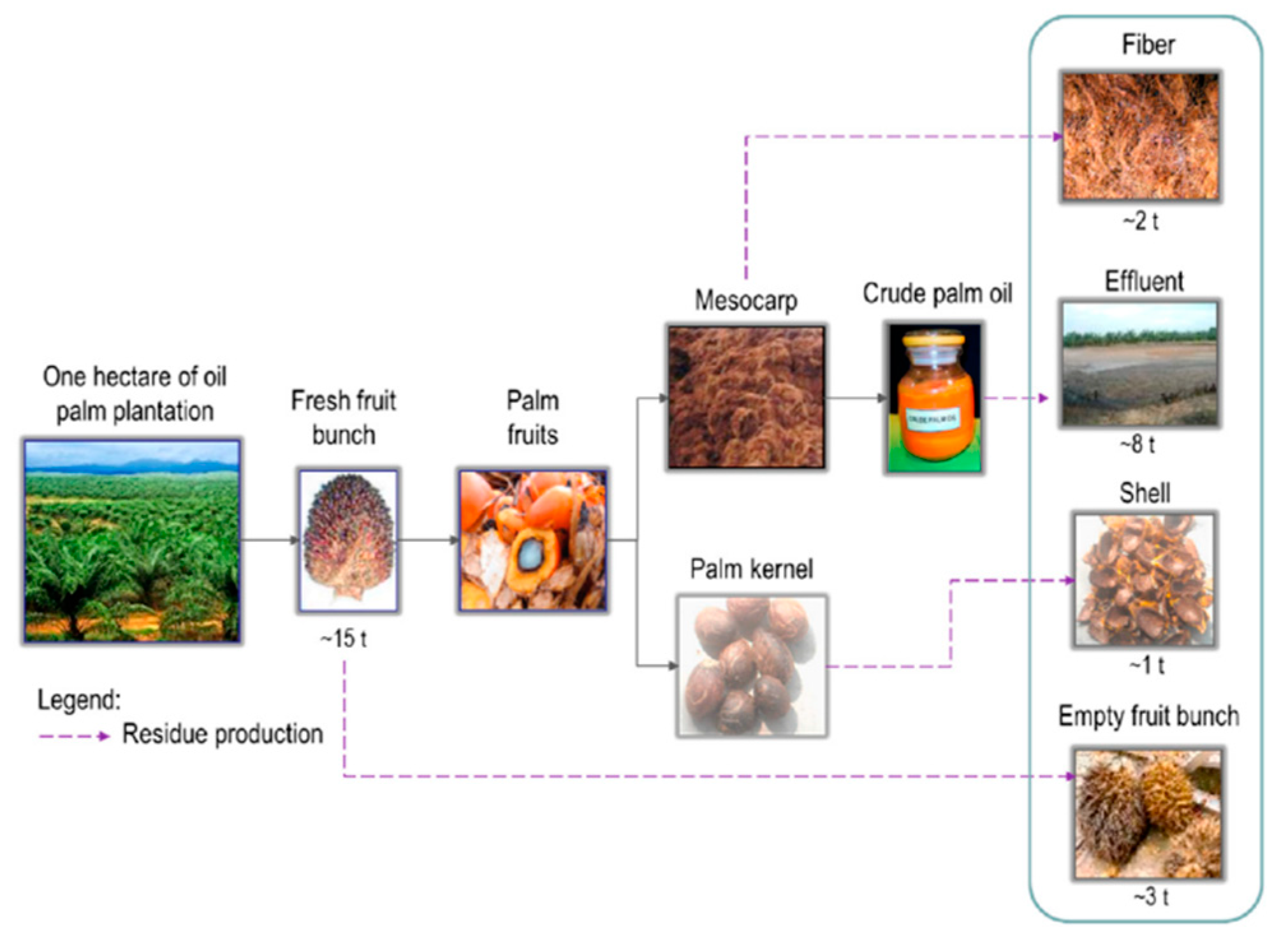
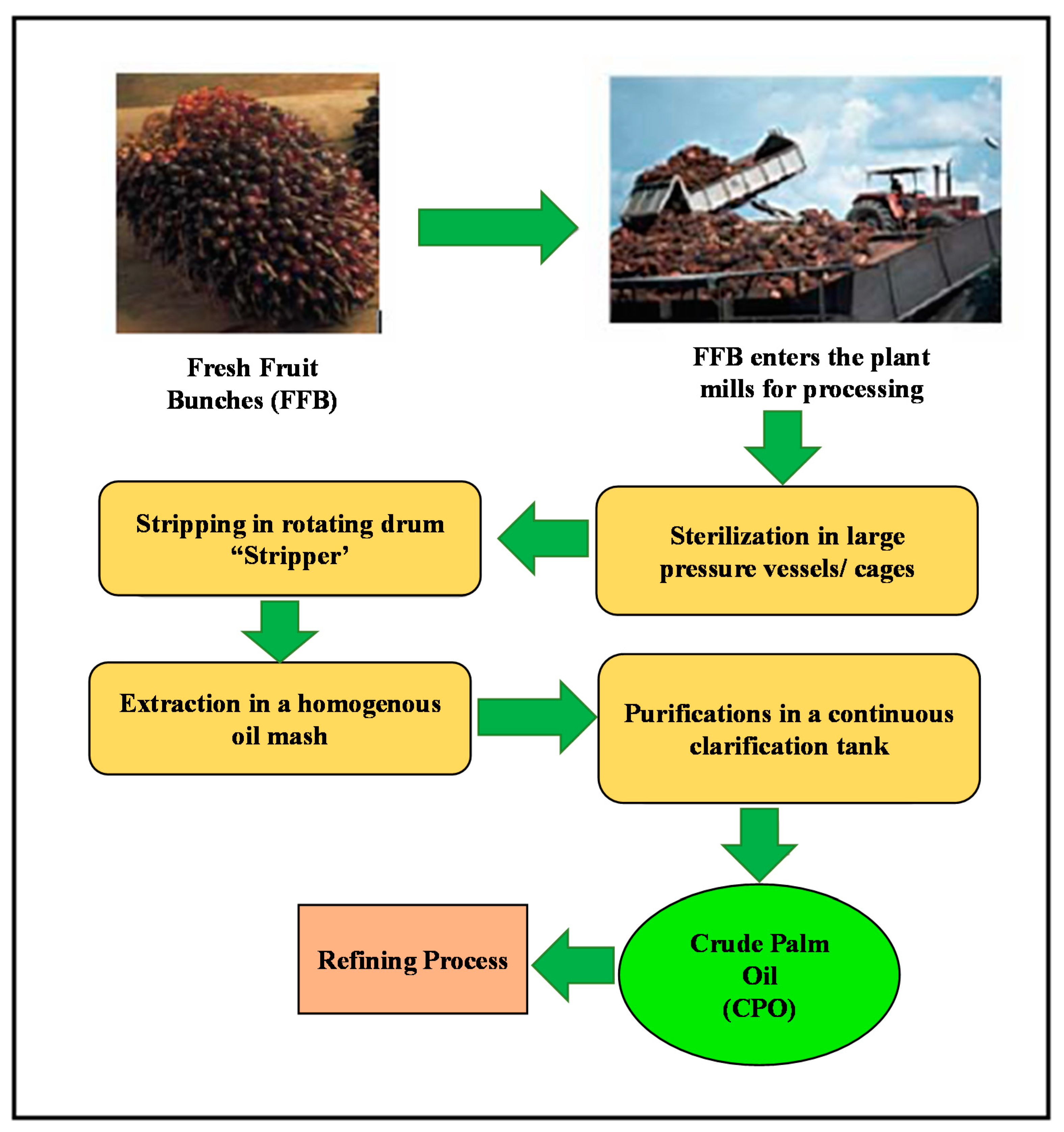
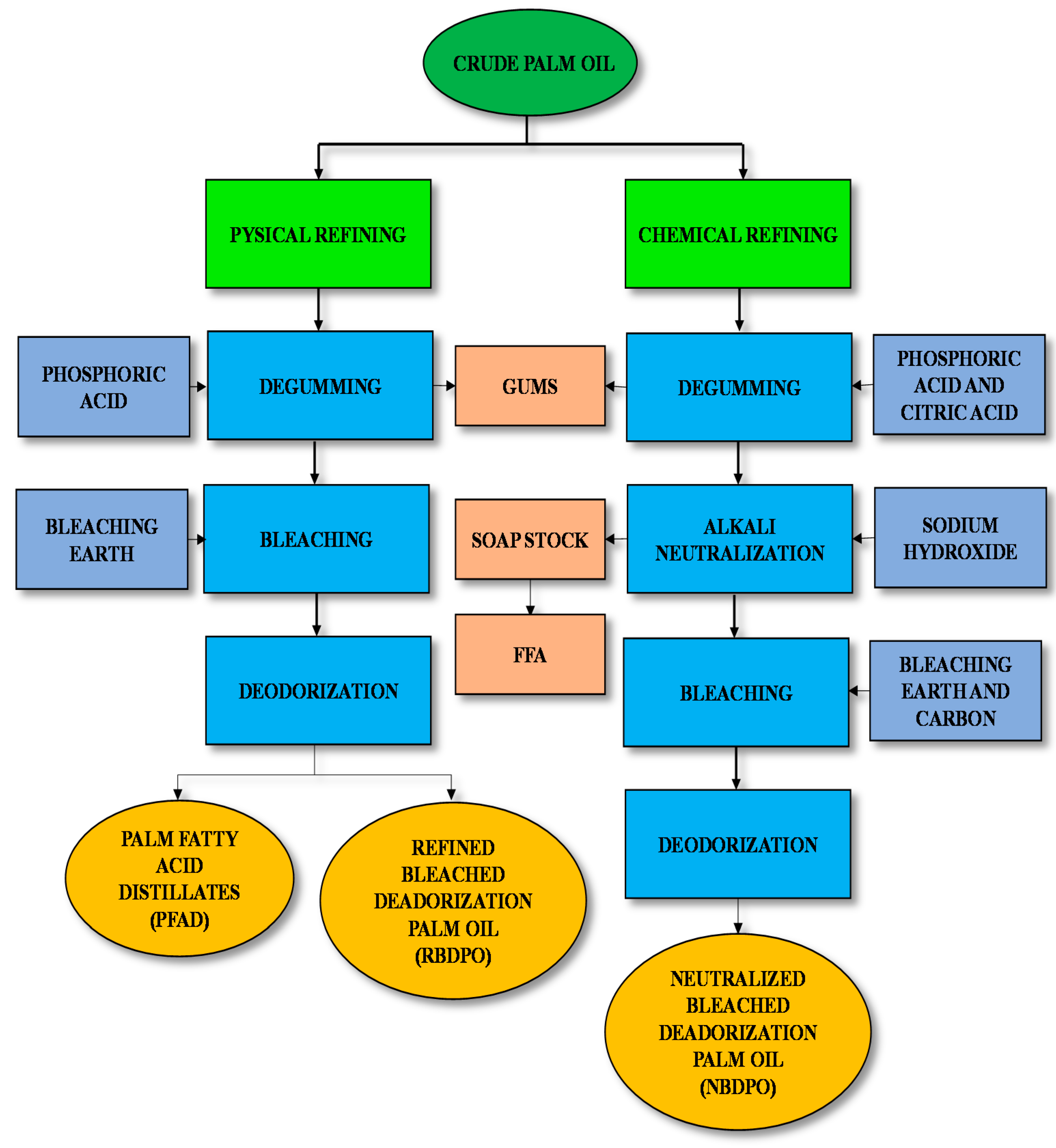




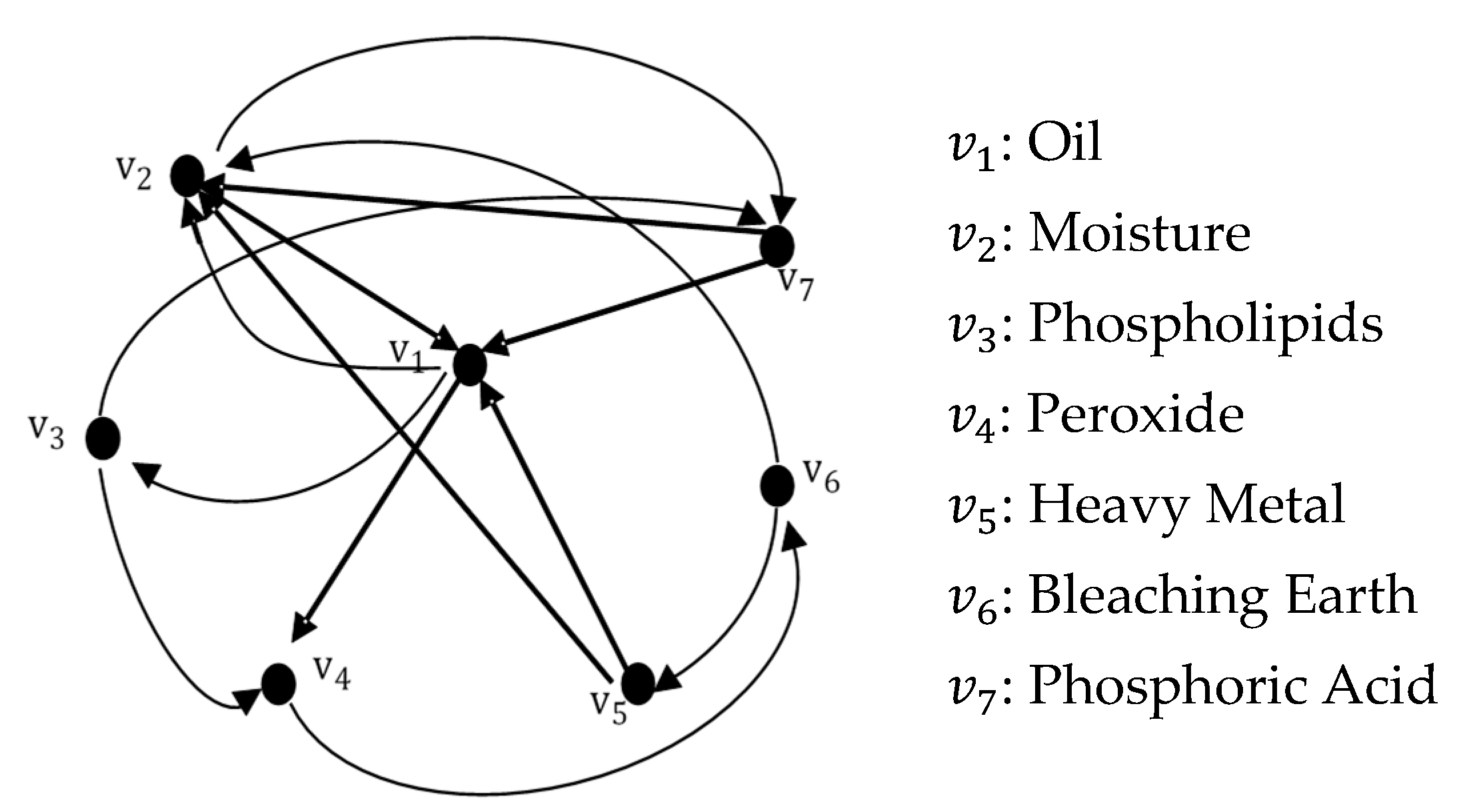
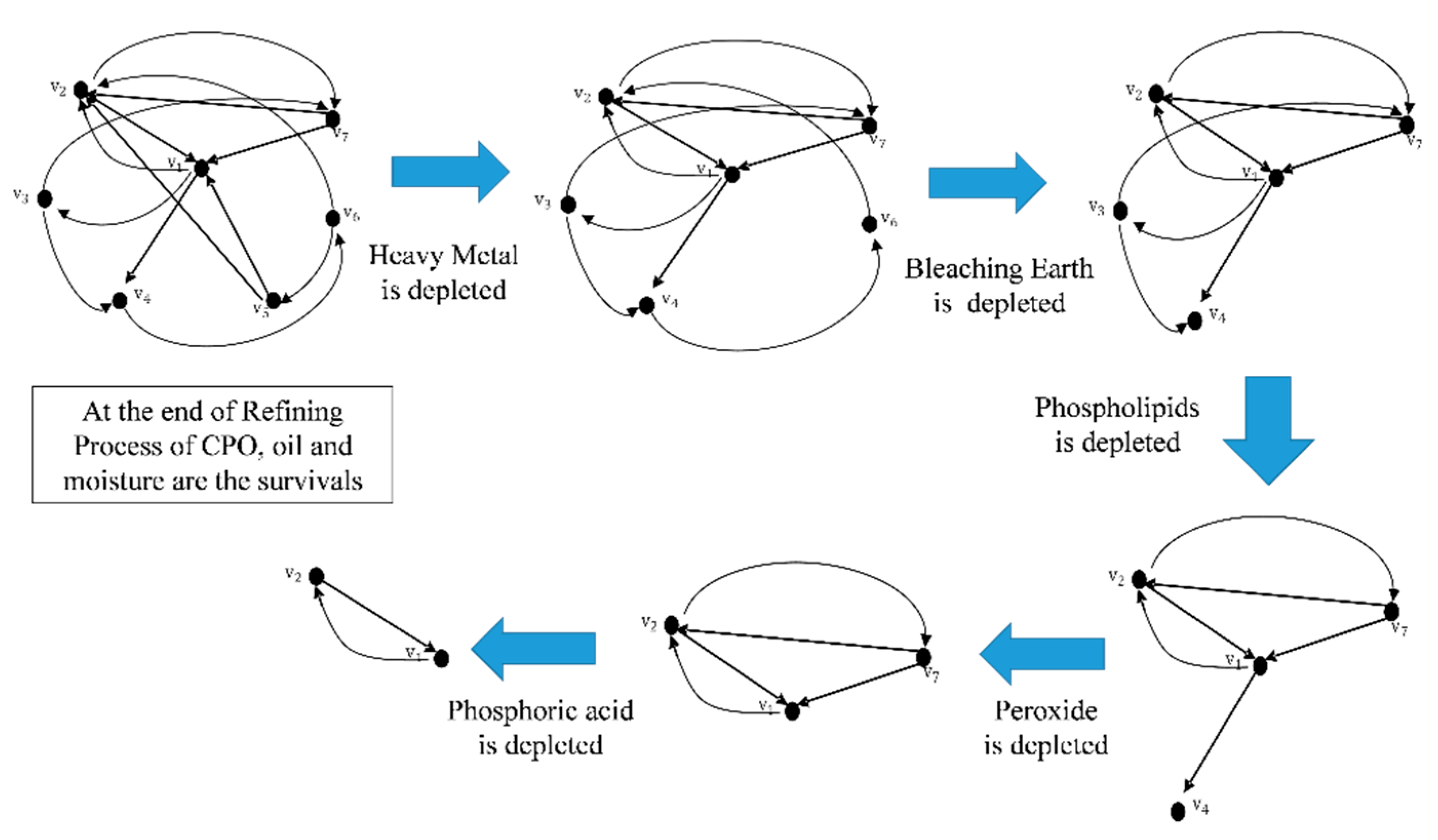
| Group | Compounds |
|---|---|
| Oil | Triglyceride, Diglyceride, Monoglyceride, Phospholipids, Glycolipid and Lipoprotein, Free fatty acids |
| Oxidized Products | Peroxides, Aldehydes, Ketones, Furfurals (from sugars) |
| Non-oil Solubles | Carotene, Tocopherols, Squalene, Sterols |
| Impurities | Metal particles, Metal ions, Metal complexes |
| Water Solubles | Water (moisture), Glycerol, Chlorophyll pigments, Phenols, Sugars (soluble carbohydrates) |
| Compounds | Crude Palm Oil (CPO) |
|---|---|
| Triglycerides | 95% |
| Free Fatty Acids, FFA | 2–5% |
| Red Color (5 ¼″ Lovibond Cell) | Orange Red |
| Moisture and Impurities | 0.15–3.00% |
| Peroxide Value, PV | 1–5.0 meq/kg |
| Anisidine Value, AV | 2–6 |
| β-Carotene Content | 500–700 ppm |
| Phosphorus, P | 10–20 ppm |
| Iron (Fe) | 4–10 ppm |
| Tocopherols | 600–1000 ppm |
| Diglycerides | 2–6% |
| Parameter | RBD Palm Oil |
|---|---|
| Free Fatty Acids, FFA | 0.1 max () |
| Moisture and Impurities | 0.1 max () |
| Iodine Value | 50–55 () |
| Melting Point | 33–39 () |
| Color | 3 or 6 Red max () |
| Parameters | Crude Palm Oil (CPO) | Degummed Bleached Palm Oil (DBPO) | RBD Palm Oil (RBDPO) |
|---|---|---|---|
| FFA | 2–5% | 3–5% | ~0.05 |
| M and I | 0.15–3.0% | ~0.2% | ~0.02 |
| PV | 1.5–5.0 | Nil | Nil |
| AV | 2–6 | 2–6 | 2–6 |
| β-Carotene Content | 500–600 ppm | - | - |
| DOBI | 2–3.5 | - | - |
| Phosphorus | 10–18 ppm | ~4 ppm | ~3 ppm |
| Iron (Fe) | 4–10 ppm | ~0.15 ppm | ~0.15 ppm |
| Copper (Cu) | ~0.05 ppm | ~0.05 ppm | ~0.05 ppm |
| Color (5.25″ Lovibond Cell) | - | - | Red 2.0 |
| Vertices | Edges | Descriptions |
|---|---|---|
| Oil catalyzes the formation of moisture. The chemical reaction is described formally as follows: | ||
| Phospholipids are produced by chemical reactions of glycerol, adenosine triphosphate (ATP), and glycerol kinase (GK). In other words, oil catalyzes the formation of phospholipids. The balance equation is adopted from [33]. | ||
| The CPO is refined at high temperature to produce oxidized compounds. Fatty acid alkyl chains catalyzed the formation of oxidized compounds. | ||
| Triglycerides oil with moisture is hydrolyzed into free fatty acids and glycerol, i.e., moisture catalyzes oil compounds. | ||
| Moisture catalyzes the formation of too. | ||
| Phospholipids such as Glycerol-3-phosphate catalyze the formation of oxidized compounds. The oxidized compound is hydrogen peroxide . | ||
| Phospholipase is used as catalyzer for the hydrolysis process that forms ester bonds between the diacylglycerol moiety and phosphoric acid [34]. | ||
| Bleaching earth consists of silica, aluminum, iron, magnesium, and calcium. When the silicon-carbon bond interacts with peroxide, then silanol (SiOH) is formed [35]. | ||
| Khairil et al. [4] presented his work on esterification process using zinc as a catalyst. Zinc is catalyzed to form oil. | ||
| Heavy metals are used as catalyzers in the formation of moisture. This formation is justified by Khairil et al [4]. | ||
| Bleaching earth consists of silica, aluminum, iron, magnesium, and calcium. The balance equation below shows that the iron in bleaching earth is catalyzed to form moisture. | ||
| The aluminum in bleaching earth catalyzes the formation of iron. | ||
| Crude glycerol is purified by acidification using phosphoric acid [35]. The is catalyzed to form FFA and monopotassium phosphate. Then, is catalyzed to form oil. | ||
| The balance equation below shows the production of moisture with weak . In other words, is catalyzed to form moisture. |
| Parameter | PFE | Description |
|---|---|---|
| Heavy Metal is depleted | ||
| Bleaching Earth is depleted | ||
| Phospholipids is depleted | ||
| Peroxide is depleted | ||
| Phosphoric acid is depleted | ||
| At the end of the refining process of CPO, oil and moisture are the final products. | ||
| Phase | Chemical Compound |
|---|---|
| t0 | Oil, Moisture, Phospholipids, Peroxide, Heavy Metal, Bleaching Earth, Phosphoric acid |
| t1 | Oil, Moisture, Phospholipids, Peroxide, Bleaching Earth, Phosphoric acid |
| t2 | Oil, Moisture, Phospholipids, Peroxide, Phosphoric acid |
| t3 | Oil, Moisture, Peroxide, Phosphoric acid |
| t4 | Oil, Moisture, Phosphoric acid |
| t5 | Oil, Moisture |
| Variable | Rate of Change for Graph Gp | Description |
|---|---|---|
| Oil Moisture | −2.5076 0.9421 | Oil and moisture are determined as survivors at the end of the refining process for palm oil. The negative sign indicates that the amount of oil decreased due to the discarded compounds in the palm oil. Moreover, the palm oil contains more than 2% free fatty acids (FFA). The FFA is removed as palm fatty acid distillate (PFAD). The final product of palm oil from the deodorization process is known as refined bleached deodorized palm oil (RBDPO) [2]. Goh [9] suggested that in order to control the quantity of FFA, CPO should be less than 0.1% of moisture. Even though moisture is present at the end of the refining process, its quantity is smaller than earlier. |
| Phospholipids | 0.8955 | Phospholipids are depleted since they contain antioxidant-synergistic characteristics that cause pro-oxidant compounds to become inactive. In general, phospholipids remove metal compounds and hydrophilic salt from the lipid phase and decrease the oxidation in CPO. Phospholipids are removed due to their reactions with phosphoric acid. |
| Peroxide | 0.8956 | Peroxide is depleted due to the existence of antioxidants such as phospholipids and heavy metal. The oxidation compounds and carotenoid pigments are removed during the deodorization process in order to preserve the flavor. |
| Heavy Metal | 0.0188 | Heavy metals are the first compound depleted since metals are used as catalyzers to decompose hydro peroxides into free radicals. They are also removed during the bleaching process [2]. |
| Bleaching Earth | −0.0546 | Bleaching earth is added during the bleaching process. Bleaching earth plays an important role in removing undesired pigment-type compounds in CPO such as phosphoric acid, pigments, trace metals, phosphatides, and oxidation compounds [2]. Therefore, the negative sign is justified as it represents the consumption of bleaching earth when it removes the unwanted compounds. |
| Phosphoric acid | −0.1899 | Similar to bleaching earth, a certain amount of phosphoric acid is added during the refining process. Phosphoric acid is used to remove phospholipids. The negative sign indicates the consumption of these compounds. Finally, the phosphoric acid is consumed by bleaching earth. |
Publisher’s Note: MDPI stays neutral with regard to jurisdictional claims in published maps and institutional affiliations. |
© 2021 by the authors. Licensee MDPI, Basel, Switzerland. This article is an open access article distributed under the terms and conditions of the Creative Commons Attribution (CC BY) license (http://creativecommons.org/licenses/by/4.0/).
Share and Cite
Ashaari, A.; Ahmad, T.; Awang, S.R.; Shukor, N.A. A Graph-Based Dynamic Modeling for Palm Oil Refining Process. Processes 2021, 9, 523. https://doi.org/10.3390/pr9030523
Ashaari A, Ahmad T, Awang SR, Shukor NA. A Graph-Based Dynamic Modeling for Palm Oil Refining Process. Processes. 2021; 9(3):523. https://doi.org/10.3390/pr9030523
Chicago/Turabian StyleAshaari, Azmirul, Tahir Ahmad, Siti Rahmah Awang, and Noorsufia Abd Shukor. 2021. "A Graph-Based Dynamic Modeling for Palm Oil Refining Process" Processes 9, no. 3: 523. https://doi.org/10.3390/pr9030523
APA StyleAshaari, A., Ahmad, T., Awang, S. R., & Shukor, N. A. (2021). A Graph-Based Dynamic Modeling for Palm Oil Refining Process. Processes, 9(3), 523. https://doi.org/10.3390/pr9030523








